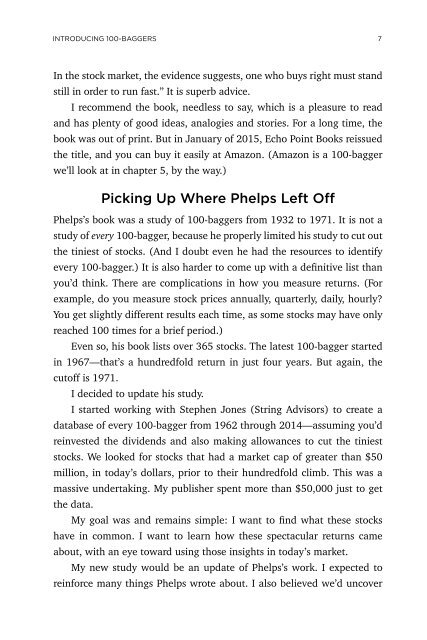You also want an ePaper? Increase the reach of your titles
YUMPU automatically turns print PDFs into web optimized ePapers that Google loves.
INTRODUCING 100-BAGGERS 7<br />
In the stock market, the evidence suggests, one who buys right must stand<br />
still in order to run fast.” It is superb advice.<br />
I recommend the book, needless to say, which is a pleasure to read<br />
and has plenty of good ideas, analogies and stories. For a long time, the<br />
book was out of print. But in January of 2015, Echo Point Books reissued<br />
the title, and you can buy it easily at Amazon. (Amazon is a 100-bagger<br />
we’ll look at in chapter 5, by the way.)<br />
Picking Up Where Phelps Left Off<br />
Phelps’s book was a study of 100-baggers from 1932 to 1971. It is not a<br />
study of every 100-bagger, because he properly limited his study to cut out<br />
the tiniest of stocks. (And I doubt even he had the resources to identify<br />
every 100-bagger.) It is also harder to come up with a definitive list than<br />
you’d think. There are complications in how you measure returns. (For<br />
example, do you measure stock prices annually, quarterly, daily, hourly?<br />
You get slightly different results each time, as some stocks may have only<br />
reached 100 times for a brief period.)<br />
Even so, his book lists over 365 stocks. The latest 100-bagger started<br />
in 1967—that’s a hundredfold return in just four years. But again, the<br />
cutoff is 1971.<br />
I decided to update his study.<br />
I started working with Stephen Jones (String Advisors) to create a<br />
database of every 100-bagger from 1962 through 2014—assuming you’d<br />
reinvested the dividends and also making allowances to cut the tiniest<br />
stocks. We looked for stocks that had a market cap of greater than $50<br />
million, in today’s dollars, prior to their hundredfold climb. This was a<br />
massive undertaking. My publisher spent more than $50,000 just to get<br />
the data.<br />
My goal was and remains simple: I want to find what these stocks<br />
have in common. I want to learn how these spectacular returns came<br />
about, with an eye toward using those insights in today’s market.<br />
My new study would be an update of Phelps’s work. I expected to<br />
reinforce many things Phelps wrote about. I also believed we’d uncover


